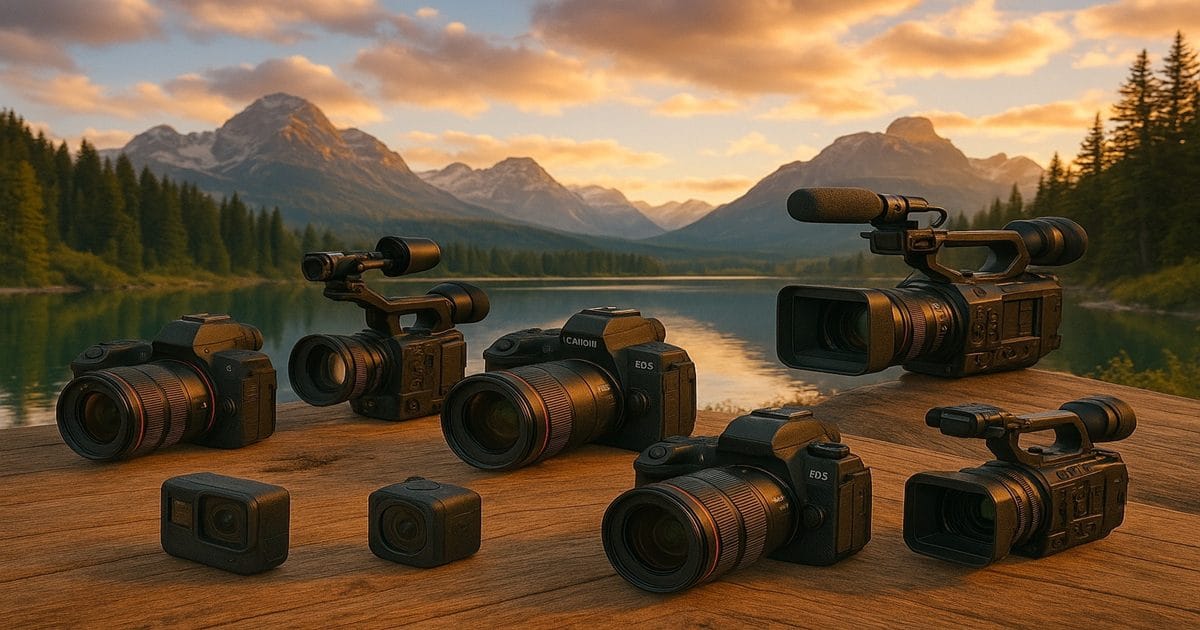Top 10 High-End Cameras for Vloggers & Enthusiasts
In the dynamic world of photography and videography, choosing the right camera can elevate your creative output from average to extraordinary. Whether you’re a passionate vlogger aiming to capture immersive travel diaries or an enthusiast craving crisp, cinematic footage, the options available today can feel overwhelming. This comprehensive review dives into ten standout models renowned for their video-friendly features, striking stills, and overall reliability. Along the way, you’ll find comparison tables, testimonials from real users, and direct calls to action for each camera so you can explore them further.
Why These Cameras Stand Out
Each camera on this list excels in a particular area—some boast robust video specs like 4K/120fps, others shine with ultra-fast auto focus, while a few excel in color science or low-light sensitivity. Vloggers typically seek cameras with flip-out screens, dependable face/eye tracking, and manageable form factors. Enthusiasts—whether into landscapes, portraits, or a smattering of everything—appreciate a sensor that can deliver sharp stills along with strong video.
To help you navigate, we’ll detail each camera’s key features, discuss ideal use cases, and throw in some personal testimonials. You’ll also see brief spec comparisons, so you can gauge performance across categories like resolution, frame rates, and auto focus. Ready to dive in?
1. Sony A7S III
Few cameras have garnered as much acclaim from content creators as the Sony A7S III.
Renowned for its exceptional low-light performance and video-eccentric features, this
full-frame powerhouse offers 4K video up to 120 fps, a fully articulating touchscreen
LCD, and real-time auto focus that consistently nails focus on faces and eyes—even
when subjects are on the move. Vloggers, in particular, love its manageable file sizes
compared to 8K behemoths, while enthusiasts appreciate the robust dynamic range for
both stills and video.
One hallmark is the new menu system, which is more intuitive than in previous Sony
generations. Its in-body image stabilization (IBIS) helps steady handheld shots,
though serious vloggers may want an external gumball for maximum smoothness. If
you’re shooting in challenging light—like Night-Capes or dimly lit indoor scenarios—
the Sony A7S III 24MP sensor excels at maintaining detail with minimal noise. Some
might bemoan the lower megapixel count for still photography, but for dedicated
videographers or low-light shooters, it’s a fair trade-off.
Testimonial:
“I moved from a crop-sensor camera to the Sony A7S III for my travel vlogs. The
low-light performance is a dream, and the auto focus never hunts for my face.
My nighttime city walk-through look so clean and cinematic now.”
2. Canon EOS R6 Mark II
Canon’s EOS R6 Mark II revamps one of their popular mirrorless lines with improved
autofocus, better heat management, and a 24MP sensor that hits the sweet spot for
both stills and video. Canon’s Dual Pixel CMOS AF II offers swift, reliable face
and eye tracking, perfect for vloggers who need to keep themselves in focus while
walking or talking to the camera.
Video specs range up to 4K 60 fps (oversampled from 6K), delivering crisp footage
without a massive crop. With a deeper buffer and new subject-detection modes,
shooting action becomes simpler—whether that’s a bike race or your toddler
running around the backyard. Another highlight is in-body stabilization (IBIS),
reducing micro-jitters for handheld shots. Combined with Canon’s color science,
the R6 Mark II often produces pleasing skin tones that require minimal grading
in post. If 8K is not your priority, but you want a robust, user-friendly camera,
the R6 Mark II might feel just right.
Testimonial:
“I’ve always loved Canon colors, but the R6 Mark II’s AF tracking
made filming my nature vlogs so much easier. Pair it with
an RF 24-105mm lens, and you can tackle both wide shots and
tight close-ups in a snap.”
3. Panasonic Lumix GH6
Panasonic’s GH series has long been a staple among pro YouTubers and indie filmmakers,
thanks to advanced video specs, reliable IBIS, and a Micro Four Thirds sensor that
hits a balance between portability and performance. The Lumix GH6 steps it up with
5.7K video recording, 4K 120 fps slow motion, and higher bit-rate formats for those
who desire maximum flexibility in color grading.
Despite the smaller MFT sensor, the GH6 boasts superior in-body stabilization,
making it a prime pick for on-the-go vlogging. Battery life is respectable,
and the camera’s fully articulating LCD plus headphone/mic jacks cater directly
to video pros. Low-light performance may lag behind full-frame rivals, but if
you prioritize advanced video features and a broad selection of compact lenses,
the GH6 stands out in the MFT space.
Testimonial:
“My GH6 has replaced my bigger cinema rig for run-and-gun documentary shoots.
4K/120 is insane for slow motion b-roll, plus the in-camera LUT support
simplifies my workflow.”
4. Sony ZV-E1
Built specifically with vloggers in mind, the Sony ZV-E1 merges full-frame capabilities
with a highly streamlined design. Sony’s AI-based subject recognition helps maintain
focus on your face even if you’re walking down busy streets, while the camera automatically
reframes to keep you in view. With an emphasis on simplicity, the ZV-E1 sports minimal
controls, but you can dive into the menu if you need advanced settings.
Video can reach 4K at up to 60 fps (plus 4K 120 fps via a paid upgrade for some models),
delivering smooth footage in good light. The highlight is the camera’s user-friendly
interface and advanced AF, making it easier for novices to capture professional-looking
content. If you want a compact, “grab-and-go” device but still crave full-frame depth
of field, the ZV-E1 is definitely a contender.
Testimonial:
“My ZV-E1 is a dream for daily vlogging. It’s super lightweight,
and I love how it auto-crops me so I’m always front and center.”
5. Canon EOS R5
The Canon EOS R5 is a powerhouse that sits near the top of Canon’s mirrorless lineup.
With a 45MP full-frame sensor and the ability to capture 8K raw video, it’s a hybrid
camera that merges high-resolution stills with advanced filmmaking potential. The
Dual Pixel CMOS AF II system covers nearly the entire frame, ensuring quick and
accurate focus lock even during action scenes.
Beware of potential overheating in 8K or 4K/120 modes, but firmware updates have
helped mitigate some issues. For many content creators who primarily shoot short
clips, the R5 offers unparalleled detail and luscious color science. If you want
to capture ultra-sharp stills—be it for large prints or cropping in post—the 45MP
sensor makes the R5 an appealing option for professionals and enthusiasts alike.
Testimonial:
“I use my R5 for both high-end product photos and event highlight videos.
The detail you can get from 8K footage is insane for zooming in post.”
6. Fujifilm X-H2S
Representing Fujifilm’s foray into serious hybrid shooting, the X-H2S sports a stacked
26MP APS-C sensor enabling high burst rates and advanced subject detection AF. For
video, it handles 4K/120p or even 6.2K recording internally, plus you get Fujifilm’s
widely praised color science and film simulations.
Unlike some older Fujifilm cameras, the X-H2S has improved autofocus that’s more
competitive with Canon and Sony. The APS-C format also means smaller, lighter lenses
compared to full-frame, making it appealing for vloggers wanting portability.
If you’re a fan of Fuji’s retro design with dedicated dials, note that the X-H2S
veers more toward a traditional DSLR-style top panel, but it’s still very user-friendly.
Testimonial:
“The X-H2S gave me everything I wanted: quick AF for sports,
beautiful Fujifilm colors, and crazy 4K slow motion.
It’s almost like having a mini cinema camera in an APS-C body.”
7. Nikon Z6 III
Nikon’s Z6 III refines their initial full-frame mirrorless approach (the Z6) by
adding dual processors, improved buffer, and better autofocus tracking. Its
24.5MP sensor provides an excellent balance of resolution and low-light capability,
and you can record 4K video up to 30 fps (60 fps through a firmware update).
While Nikon’s autofocus historically lags behind Sony or Canon for fast-moving
subjects, the Z6 III’s Eye-AF is a welcome upgrade for vloggers or portrait
shooters wanting consistent focus on faces.
Nikon’s color output often appeals to those seeking a more neutral or subtle
look straight out of camera. And if you’re an existing Nikon DSLR user,
FTZ adapters let you use F-mount glass with minimal penalty. For stills,
the camera handles burst rates up to 14 fps, making it capable of some
sports or action—though not at the top tier. If you’re a Nikon loyalist
or want a reliable all-rounder that does photos and basic 4K video,
the Z6 III remains a solid choice.
Testimonial:
“I’ve been a Nikon shooter for years, so going mirrorless with the Z6 III was natural.
Video looks great, and I love that I can use my F-mount lenses with the FTZ adapter.”





